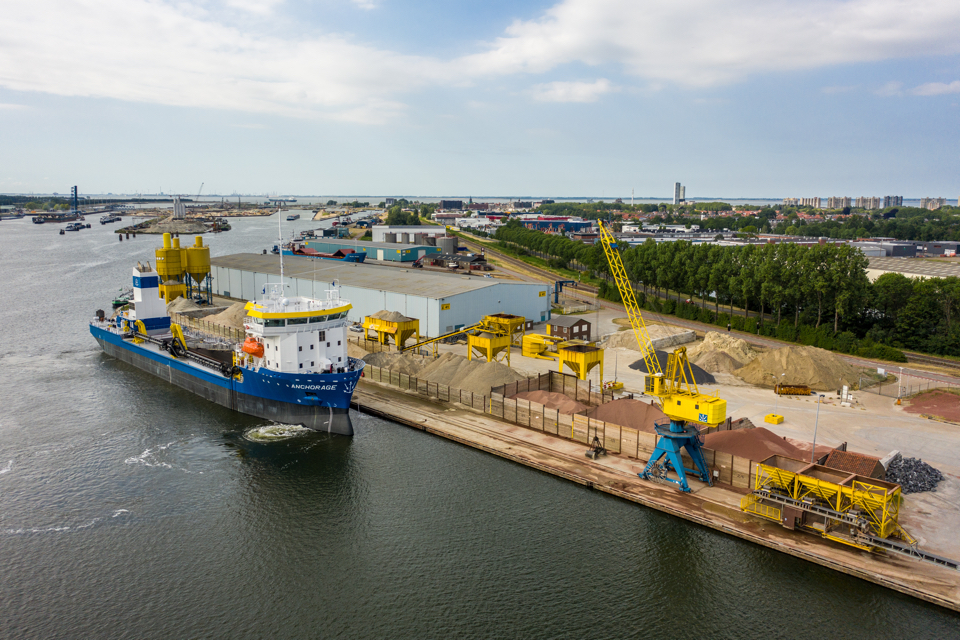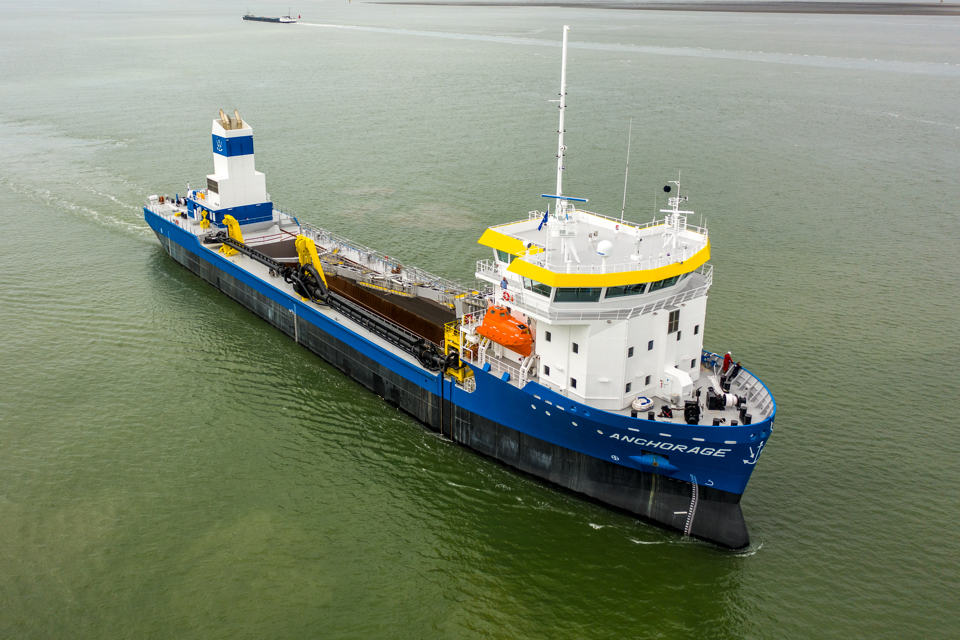Barkmeijer Shipyards has delivered the Anchorage to De Hoop Terneuzen. This trailing suction hopper dredger has been designed to dredge sand and gravel up to a depth of sixty metres, to screen this to the required grain size and for dry discharge to shore in ports with a great variety in receiving facilities.
De Hoop Terneuzen is a supplier of building materials in Holland and Belgium. The design of the sand and gravel dredger is based on dry discharge either by a shore based crane or a self-unloading installation. The suction tube is equipped with a submerged dredge pump. The dredged raw materials are both used for processing in the company’s own facilities or to be delivered to clients.
The design brief for the dredger was rather comprehensive. Without limits to the navigation area, the design had to be able to dredge sand and gravel in water depths of up to sixty metres as well as to be able to discharge its cargo in ports with a variety in receiving facilities. In addition, the sand and gravel had to be screened to the required grain size.
An extensive study of the ports in Northwestern European mainland and the UK considering limitations in length, beam, water depth, air draught and port facilities made for an optimised design. It is characterised by a high freeboard for operations at the high seas. No bottom doors are foreseen, as the intention of this vessel is to unload the aggregates ashore. The ship is laid out at a loaded speed of fourteen knots, which is quite fast for a dredger, in order to reduce the transfer time between the deeper concessions and the discharge ports.
High manoeuvrability is obtained by two azimuth thrusters and a tunnel type bow thruster. A telescopic spud pole mooring system has been installed, extending nineteen metres under the ship’s bottom, for easy positioning during discharge operations.
Diesel-electric and dynamic power management
The dredger has been designed with state of the art technology. The hull of was designed by and built at Barkmeijer in Stroobos. The hull shape is optimised for sailing at both loaded and unloaded draught by Computational Fluid Dynamics (CFD) calculation.
Anchorage is equipped with a smart diesel-electric system, developed in close collaboration between Barkmeijer Shipyards and D&A Electric, that efficiently regulates the energy supply for sailing, dredging and unloading the ship. The use of the E-prop electric propulsion increases the overall propeller efficiency, where, as a result, energy and fuel consumption is optimized and the ship’s emissions are greatly reduced.
The dredger is powered by three Mitsubishi SU medium speed diesel generator sets. Two of 2550 eKW each and one of 1275 eKW. The gensets are able to run all three parallel, or twin, or single, depending on the required power for each specific operation, for instance: dredging and sailing, discharging, or just sailing. The different setups of the gensets ensure the most efficient load of the gensets, which results in the lowest possible fuel consumption.
Fuel efficiency has further been optimised by features, such as the ability to use shore power for all ship systems during port stay, extensive use of waste heat recovery, variable speed pumps and ventilators, high efficiency electric motors for all applications en LED lighting for the complete vessel.
D&A Electric’s Dynamic Power Management System avoids any overload on the active power generation. Propulsion, bow thruster and main pumps are efficiently controlled to avoid peak loads on the generators. The installation does not require peak shaving at all.
One-man operation system
For the control and monitoring of all ship’s systems and the dredging process, Barkmeijer Shipyards collaborated with system specialist Alewijnse Marine. They have developed an integrated intelligent automation package. This programmable logic controller (PLC) based Alarm, Monitoring & Control System with 26” Scada HMI workstations includes the remote control of engine room systems, ventilation, lighting and the hydraulic equipment related to the dredging installation. The PLC system provides the control logic, alarm logic and interlocks in the system. For monitoring of the drag arm and the performance of the dredging process a Dredge Control System module is integrated with a large number of sensors in the dredge system.
The wheelhouse is equipped with multiple control positions, enabling one man control during sailing, dredging and unloading operations. The integrated system provides not only high dredging performance, but also enables the dredging, sailing and maintenance operations to be handled by a limited crew.
Special equipment
Anchorage has been built especially for extracting sand and gravel at sea, with a capacity of 3000 cubic metres per hour. A submerged underwater pump, mounted in the suction pipe, brings the sand/gravel mixture to a sieve, which separates the sand and gravel and deposits the preferred cargo into the hopper (cargo hold of the dredger) and discharges the unwanted material back into the sea. Then during the trip to the port of discharge, the water is removed from sand or gravel, so that the cargo can be unloaded “dry” by the ship’s onboard ship-to-shore discharge system.
The dry discharge equipment was developed in close cooperation with De Hoop. The equipment consists of a carriage travelling over the hopper, equipped with an eight-metre wide grab.

In the normal situation, the sand ends up on a belt that runs all the way along the ship and can be discharged to shore from the stern with a swivelling conveyor belt of forty metres long. As a special feature, a transverse conveyor belt on the carriage can be telescopically extended, in order to load an inland vessel alongside, with the belt travelling along so that the inland vessel is loaded in a nicely distributed manner.
In this way, an average 1200 cubic metres per hour can be unloaded. Both the conveyor belts and the unloader carriage are electrically driven by frequency controllers from the ship’s system. To avoid extreme load variations, peak shaving is applied with the use of a capacitor bank.
Accommodation is provided for fourteen persons in separate cabins, and is characterised by high ceilings, efficient insulation, very low noise levels, individual climate control and gym facilities for a high degree of comfort.
Of Dutch design and build
TSHD Anchorage was developed and built in the Netherlands in collaboration with Dutch suppliers, mainly from the northern part of the Netherlands. The design and construction of the dredger, build number 347, was undertaken by Barkmeijer Shipyards in Stroobos, part of the Thecla Bodewes Shipyards Group. In April 2019, the hull was towed to their shipyard in Harlingen, where the final outfitting, electrical works, installation of all engine room equipment, dredging equipment, technical spaces and pump room was done. The vessel particulars are:
- Classification Society: Bureau Veritas
- Length over all: 105.90 m
- Length bpp: 100.55 m
- Breadth: 15.85 m
- Depth: 8.85 m
- Draught summer: 6.94 m
- Speed: 15 knots
- Hopper capacity: 3200 m3
- Gross Tonnage: 4343
- Air draught at 5.00 m draught: 22.00 m
- Inside diameter of drag arm: 700 mm
- Maximum dredge depth: 60 m
- 3 Main Diesel Alternator sets total installed power: 6375 ekW
- 1 Emergency / Harbour Diesel Alternator set power: 243 ekW
- 2 Rudder propeller units driven by electric motor each: 2100 kW
- 1 Bow thruster driven by electric motor: 600 kW
- 1 submerged dredge pump driven by 3.3 kV electric motor: 1350 kW
- 1 jet pump driven by electric motor: 500 kW
- 1 flow acceleration pump driven by electric motor: 260 kW








